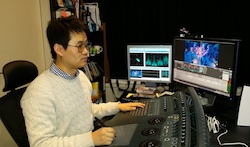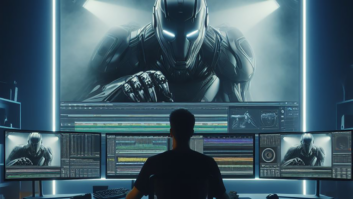
4K is already routine for the Korean post and broadcast facility, CJ Powercast Contents Business, which has worked on images of up to 27K, and has just bought a Quantel Pablo Rio finishing system to enable it to more easily do Ultra HD and 4K Stereo 3D work.
CJ Powercast is mainly working on colour grading, computer graphics, editing, mastering, 2K to 4K blow up for exhibitions, BTL contents, soft drama, commercials, etc., “with a heavy focus on delivering the very best image quality,” said Junho Yun, CJ Powercast’s technical supervisor and colourist (pictured).
“We normally use Quantel products when we need to work with images higher than 4K. For example, in 2012 we worked in the LOTTE Pavilion at Expo 2012 Yeosu Korea working with an output image of 27K. Of course we didn’t work with the 27K image as a single entity, but our Quantel system helped us to create a stunning canvas and it made the process straightforward and effective,” he said.
“We mainly use a 16-bit tiff format but for Quantel products we handle both 10-bit and 16-bit depending on the original source when importing. In some cases 10-bit DPX and raw data are also used. For this reason we don’t confine ourselves to a one size fits all workflow; we adapt our methods to suit the individual characteristics of different production formats so that we can faithfully handle the finest details and deliver the best possible end quality whatever the format used,” he added.
“We have been working with greater than 4K since 2007, mostly for multi-screen display,” mainly using Quantel’s iQ and then Pablo 4K. “As the I/O card we had did not support 4K, we created it with 4K data but monitored it with 2K data. At that time, it was possible to persuade our clients that 4K monitors had not come into wide use then. We are currently working with 4K/UHD at present and our client also wants to get a 4K/UHD monitor in case of a demand for work greater than 4K,” Yun explained.
He believes that Pablo Rio’s high performance and stability “will help us move smoothly into 4K/60p and 4K S3D operations,” although there is currently relatively little demand for 4K/60p production in Korea, it is emerging for some applications. “I expect the move to 4K/60p will develop quickly in Korea” during 2014 through such opportunities as a home choice UHD channel and aggressive marketing for UHD TV sets by manufacturers.
“On the other hand, I think 4K S3D is different. It might not be as big as 4K/60p, but I think it will continue to be demanded for specific projects. Personally I am a big supporter of S3D and I am looking forward to it continuing to develop as a major format in the market again,” said Yun.
The Pablo Rio will operate alongside CJ Powercast’s existing Quantel Pablo and PA systems, allowing the creative team to share projects across systems, and will be equipped with the Neo colour panel. “We have been using Quantel systems since 2006 and have never experienced any loss of media or data in that time,” added Yun. Rio and Neo are being supplied via Quantel’s Korean partner, QAC Korea.
CJ Powercast, part of the multi-national CJ Group, was founded in 2003 to provide production, post production and content delivery services to the group’s rapidly expanding portfolio of broadcast stations.
By David Fox







